“Barney” and “Beakey” are two barn swallows temporally residing here in Thurles, Co. Tipperary, which we have been carefully watching.
In the last few days they have produced their second brood of chicks, having built two nests, the most recent construction within about 3.66meters (12ft) of their previous abode.

Swallows spend their winter in southern Africa, migrating across the Mediterranean Sea and the Sahara Desert to Ireland in spring to return home using the same return route in early September.
They build cup-shaped nests in barn rafters, under roofs, using mud pellets, hair, grass, and feathers as seen here above.
It can take a pair of swallows up to 1,100 journeys to build their nest, with the female only permitted to line it; in the case shown above “Beakey” used a layer of dried grass on top of the mud pellets, before covering it in a mixture of soft feathers.
Most of our Irish swallows try to rear two broods each summer and some early arrivals succeed in raising three. The male swallow in this case “Barney” arrived back in the Thurles area first and was heard singing over his territory awaiting to attract a mate. Females, (like most women) don’t mind keeping their men waiting, generally arriving up to a week late, looking virtually identical in appearance to their male counterparts. [Males have longer outer tail-streamers than females and have also more gloss to their outer feathers.]
Swallows always return to the same location to nest every year, so the number of birds nesting in any one area can grow year after year.
Not even distantly related to their somewhat look alike Swift family; having watched them year after year, the true home of barn swallows is in our skys where they feed almost exclusively on midges and flies caught during their erratic, high speed flight. They can be observed even drinking on the wing, flying low to sip water.
Swallows nests, their eggs and chicks are protected under the Wildlife Act 1976 and Wildlife (Amendment) Act 2000 and European-level legislation. The penalties for tampering with swallows or disturbing their active nests consists of heavy fines and even imprisonment.

Leave a Reply